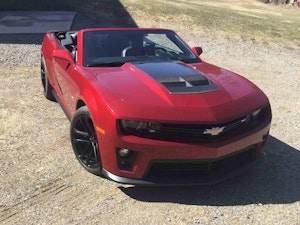Media | Articles
The first-gen Monte Carlo can’t keep up with Chevelle or Grand Prix
Chevrolet’s first-generation Monte Carlo, which ran from 1970-72, shares quite a lot with its sportier Chevelle brethren. It uses a modified A-body chassis with a longer wheelbase that’s expressed by way of a longer hood. It’s the same formula Pontiac used beginning in 1969 to create the Grand Prix. However, Monte Carlo values aren’t keeping pace with Pontiac’s sporty personal luxury car or the muscly Chevelle SS. What gives?
Bridging the gap between sporty Chevelle and cruising Caprice, the Monte Carlo was only offered with a formal hardtop roof, like the also-long Grand Prix and regular-length Oldsmobile Cutlass Supreme. Sporting unique exterior sheetmetal, the Monte showed its Chevelle roots inside, using the same dash, this time with a veneer of woodgrain. Like the Chevelle, the Monte Carlo could be had with some of Chevrolet’s most potent big-block V-8s, with the exception of the fire-breathing LS6 454, presumably because Monte Carlo’s more luxury oriented audience couldn’t be bothered with the noise and nuisance of adjusting lash on the LS6’s solid lifter cam. The LS5 454 was still available for big-block devotees.
The highest values for first-gen Montes are found in the SS 454 from 1970 and 1971, both with #2 (excellent) values of around $34,000. That’s about $15,000 less than a 1970 Chevelle SS 454 equipped with the same LS5 engine. Meanwhile, the 1970 Pontiac Grand Prix SJ shows a #2 value of $37,600. Both the Grand Prix and Monte have increased in value over the past five years, with the base model ’70 and ’71 Monte Carlos up about 30 percent to their current values. The Monte Carlo has been flat since 2018, however, while the Grand Prix still continues to climb.
We spoke with valuation specialist Greg Ingold to see if we could understand why the Monte Carlo is lagging behind not just the mechanically similar Chevelle, but also a vehicle that was similarly positioned in the marketplace. Ingold noted that the value trend is unusual, “Monte Carlo has been a bit more sluggish to gain value versus the Pontiac. That is a bit of a reversal from what is normal considering that Chevrolets are typically quicker to gain value compared to their sister cars.” Part of that can be attributed to the fact that the Grand Prix was positioned further upmarket. Ingold explained, “Pontiac did a better job on the performance aspect. Their brochure says ‘We don’t build a luxury car. We build a performance car and then we make it luxurious.’” They backed that promise up by offering only performance-oriented engines, with a base Grand Prix getting the same 400 as a GTO, while a base 1970 Monte Carlo came with a 300-horsepower, 350-cubic-inch small-block.
Like the Caprice, it seems the Monte Carlo is haunted by living in the shadow of a car with a better muscle car reputation. On the other hand, it offers buyers with a great entry into the muscle car realm with a vehicle that has ubiquitous aftermarket restoration and hot-rodding support thanks to using GM’s A-body chassis components and Chevrolet V-8 engines. Ingold adds, “I think the Monte Carlo’s biggest problem is the Chevelle. It is a lot sportier-looking and had the performance cred. That said, an SS 454 Monte Carlo with the LS5 is a lot of bang for your buck.”
Marketplace
Buy and sell classics with confidence
20190523200145)








20190523200215)
20190523200156)
20190523200225)
20190523200237)
20190523200244)

